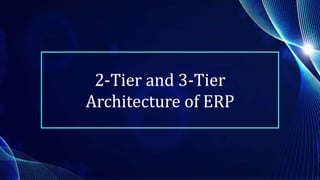
2-Tier and 3-Tier Architecture of Enterprise Resource Planning
- 1. 2-Tier and 3-Tier Architecture of ERP
- 2. SUBMITTED TO: SUBMITTED BY: Mr. Shobhit Kumar Asst.Professor S M Qamar Abbas GUID: 19GSOB2010450 Batch: 4 Session : 2019-2020 Introduction to ERP & MIS (MBDS5031)
- 3. 2-Tier Architecture A two-tier architecture is a database architecture where 1. Presentation layer runs on a client (PC, Mobile, Tablet, etc) 2. Data is stored on a Server. An application interface which is called ODBC (Open Database Connectivity) an API which allows the client-side program to call the DBMS. Today most of the DBMS offers ODBC drivers for their DBMS. 2 tier architecture provides added security to the DBMS as it is not exposed to the end user directly. Example of Two-tier Architecture is a Contact Management System created using MS- Access. In the above 2-teir architecture we can see that one server is connected with clients 1, 2m and 3. This architecture provides Direct and faster communication.
- 4. 3-Tier Architecture 3-tier schema is an extension of the 2-tier architecture. 3-tier architecture has following layers 1. Presentation layer (your PC, Tablet, Mobile, etc.) 2. Application layer (server) 3. Database Server This DBMS architecture contains an Application layer between the user and the DBMS, which is responsible for communicating the user's request to the DBMS system and send the response from the DBMS to the user. The application layer(business logic layer) also processes functional logic, constraint, and rules before passing data to the user or down to the DBMS. Three tier architecture is the mostpopular DBMS architecture.
- 5. What is Difference between Two-Tier and Three-Tier Architecture ? Two-Tier Architecture: The two-tier is based on Client Server architecture. The two-tier architecture is like client server application. The direct communication takes place between client and server. There is no intermediate between client and server. Because of tight coupling a 2 tiered application will run faster.
- 6. The above figure shows the architecture of two-tier. Here the direct communication happens between client and server, there is no intermediate layer between client and server. The Two-tier architecture is divided into two parts: 1. Client Application (Client Tier) 2. Database (Data Tier) On client application side the code is written for saving the data in database server. Client sends the request to server and it process the request & send back with data. The main problem of two tier architecture is the server cannot respond multiple request same time, as a result it cause a data integrity issue. When the developers are not disciplined, the display logic, business logic and database logic are muddled up and/or duplicated in a 2tier client server system. Advantages: 1. Easy to maintain and modification is bit easy. 2. Communication is faster. Disadvantages: 1. In two tier architecture application performance will be degrade upon increasing the users. 2. Cost-ineffective.
- 7. Three-Tier Architecture: Three-tier architecture typically comprise a presentation tier, a business or data access tier, and a data tier. Three layers in the three tier architecture are as follows: 1. Client layer 2. Business layer 3. Data layer 1.Client layer: Represents Web browser, a Java or other application, Applet, WAP phone etc. The client tier makes requests to the Web server who will be serving the request by either returning static content if it is present in the Web server or forwards the request to either Servlet or JSP in the application server for either static or dynamic content.
- 8. 2. Business layer: This layer provides the business services. This tier contains the business logic and the business data. All the business logic like validation of data, calculations, data insertion etc. Are centralized into this tier as opposed to 2-tier systems where the business logic is scattered between the front end and the backend. The benefit of having a centralized business tier is that same business logic can support different types of clients like browser, WAP (Wireless Application Protocol) client, other standalone applications written in Java, C++, C# etc. This acts as an interface between Client layer and Data Access Layer. This layer is also called the intermediary layer helps to make communication faster between client and data layer. 3. Data layer: This layer is the external resource such as a database, ERP system, Mainframe system etc. responsible for storing the data. This tier is also known as Data Tier. Data Access Layer contains methods to connect with database or other data source and to perform insert, update, delete, get data from data source based on our input data. Following diagram representing the 3-tier architecture.
- 9. Advantages: • High performance, lightweight persistent objects. • Scalability – Each tier can scale horizontally. • Performance – Because the Presentation tier can cache requests, network utilization is minimized, and the load is reduced on the Application and Data tiers. • Better Re-usability. • Improve Data Integrity. • Improved Security – Client is not direct access to database. • Forced separation of user interface logic and business logic. • Business logic sits on small number of centralized machines (may be just one). • Easy to maintain, to manage, to scale, loosely coupled etc. Disadvantages: • Increase Complexity/Effort
- 10. Thank You